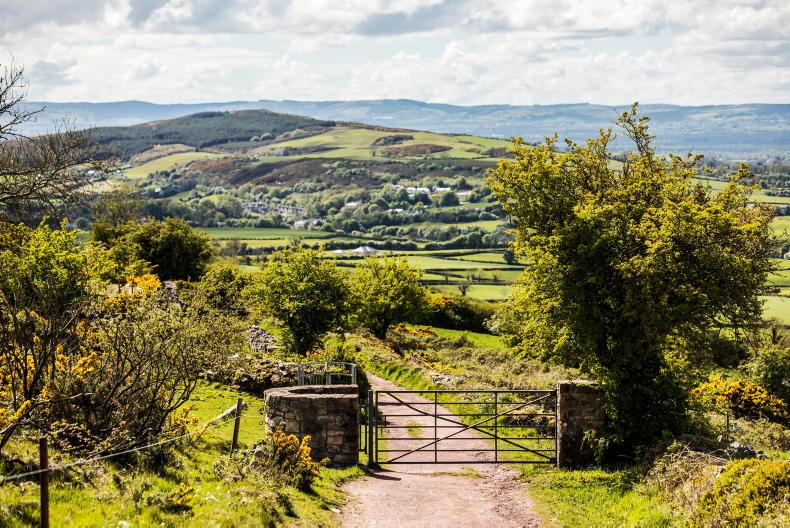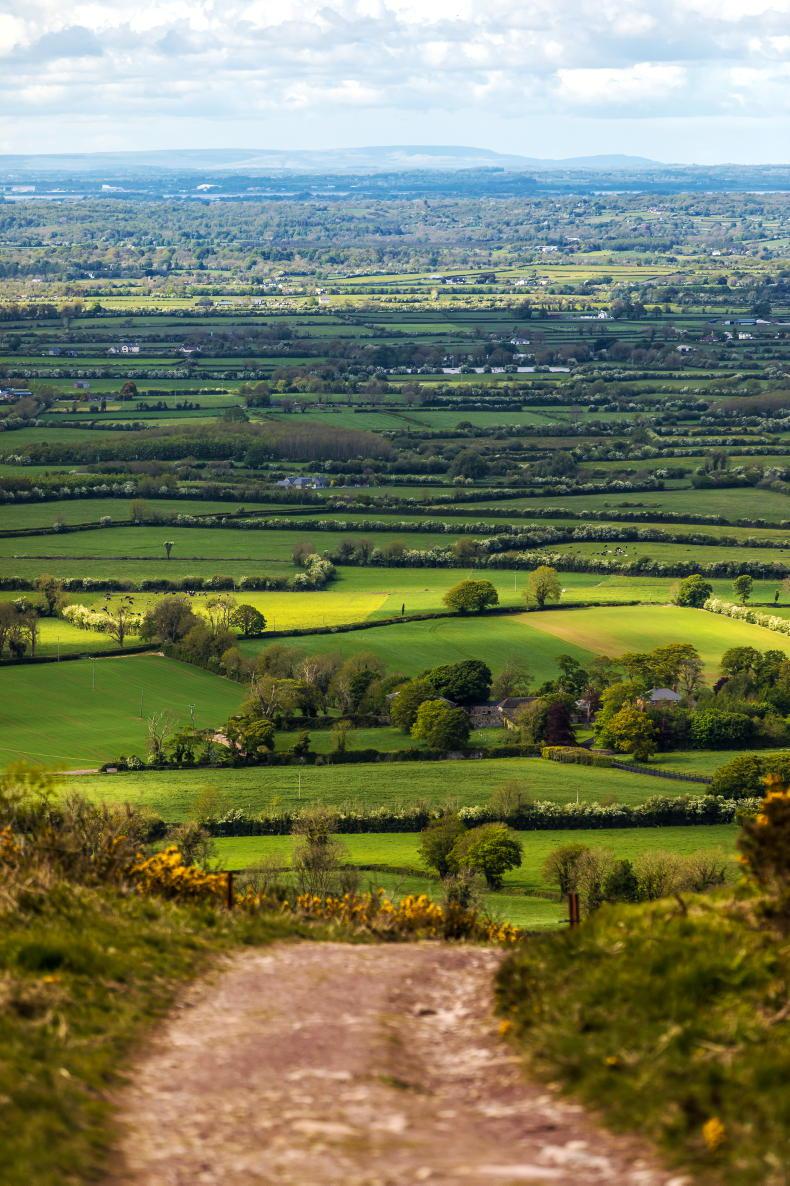I grew up in Tulla, Co Clare. Brothers of mine went to England, they came back and bought farms of land. I live in Rathkeale, Co Limerick now and I keep a few cattle myself as well.
How I went from Clare to Limerick, well, it was through work.
After leaving school I got a job in a grocery shop in Tulla. Then I worked in Gort for a short time in a pub and I met my wife at a dance there. After that I got a job in Dromoland Castle as a night porter. I worked in various different roles for the man who owned that group of hotels at the time.
I left that and I worked as a manager in Neodata in Killmallock and Newcastle West, that’s how I ended up in west Limerick. After that I started up my own auctioneering business. Our office is in Newcastle West, O’Donovan and Associates. We’ve been in it over 40 years.
The hill
Knockfierna Hill outside Ballingarry in Co Limerick stands at 949ft, has a surrounding view of five counties and is looking onto the River Shannon. The name means ‘hill of the fairies’ or ‘hill of truth’.
There was a huge population in Knockfierna before the famine. In 1841 there were 629 people living in Knockfierna in 123 occupied houses. By 1901, 91 people lived here and there were 26 houses occupied.
Now, this house is the only remaining house on the hill that’s habitable. The last person that lived on the hill died in 1960.

The view from Knockfierna Hill. \ Philip Doyle
In 1973 when I bought this property here on the hill, that’s now Knockfierna Rambling House, you had to have a stick coming up the passage because it was closed in with briars and bushes. Gradually over the years we got the passages cut.
Many people were delighted I bought it because it has preserved the trackways, the walkways and the old fields. It’s a very popular place with walkers now.
Rambling house
In 1987 we formed the Knockfierna Heritage Society, which is still in operation today and I’m the chairman. The first thing we did was organise a Festival of Lughnasa on the hill. Lughnasa was traditionally celebrated on the hill.
We held mass as well. We probably had 2,000 people at one of the masses in the early years.
Knockfierna Heritage Society also organise nights in the Rambling House. We felt that it was important that older people should be recorded talking about what life was like for them. There’s also music on those nights.
For example, the older people spoke about the postman delivering post on his bicycle on Christmas Day. He’d be fairly well jarred because he’d get drink in most of the houses. There were dances on Christmas night, the Penny Hops they’d call them.
They outlined what they would buy when they went shopping at Christmas. They’d do the shopping just a few days before Christmas, not in September like they do now. Post was delivered every day of the week, even on Sunday.

The view from Knockfierna Hill. \ Philip Doyle
We have had wonderful seanchaís in the Rambling House and great musicians. We also had a lot of young, budding musicians and singers perform here. They just stood in front of the fire and got a round of applause, no criticism and if they made a mistake they could start again. It was all encouragement.
The use of this house has always been made available to the Knockfierna Heritage Society free of charge.
We also preserve and protect a lot of the old ruin buildings on the hill. There’s lots of famine houses and most recently we made a walkway around the sweat house.
Commemoration
On Sunday 9 October we’re going walking the 5k from Ballingarry to the top of Knockfierna. This is to commemorate an event that took place here 175 years ago.
It was the height of the famine, people were starving and they were living in terrible, wretched conditions. Over 1,000 people walked from the town of Ballingarry to the top of Knockfierna Hill.
It was an old tradition from Celtic times, people marching on hill tops. They did this for the Festival of Lughnasa, but also in times of distress and protest.
At that time they were demanding food. The crowd swelled as they were on the way and they were beating drums, cans and whatever they could lay their hands on.
Following that then, the army were brought out, because this hill side is looking out on the finest of land. It was controlled by the local landlords.
The starving people here on the hill were looking down at the finest of crops and the finest of animals. It was quite regular that there would be an attack on movement of meal or cattle to the port in Limerick. So the army were moved out to a base on Knockfierna Hill.
People who mightn’t be able to do the full walk can join us here at the Rambling House at about half past two.
It should be a lot easier for people today who are well fed and fully clothed to make that walk. When you think of the people and the conditions they were living and walking in in 1847. It’s not too far and the view will be easy on the eye as well, of course.”
Read more
Listen: Forgotten Christmas traditions
Engaging people with outdoor art galleries in Co Limerick
I grew up in Tulla, Co Clare. Brothers of mine went to England, they came back and bought farms of land. I live in Rathkeale, Co Limerick now and I keep a few cattle myself as well.
How I went from Clare to Limerick, well, it was through work.
After leaving school I got a job in a grocery shop in Tulla. Then I worked in Gort for a short time in a pub and I met my wife at a dance there. After that I got a job in Dromoland Castle as a night porter. I worked in various different roles for the man who owned that group of hotels at the time.
I left that and I worked as a manager in Neodata in Killmallock and Newcastle West, that’s how I ended up in west Limerick. After that I started up my own auctioneering business. Our office is in Newcastle West, O’Donovan and Associates. We’ve been in it over 40 years.
The hill
Knockfierna Hill outside Ballingarry in Co Limerick stands at 949ft, has a surrounding view of five counties and is looking onto the River Shannon. The name means ‘hill of the fairies’ or ‘hill of truth’.
There was a huge population in Knockfierna before the famine. In 1841 there were 629 people living in Knockfierna in 123 occupied houses. By 1901, 91 people lived here and there were 26 houses occupied.
Now, this house is the only remaining house on the hill that’s habitable. The last person that lived on the hill died in 1960.

The view from Knockfierna Hill. \ Philip Doyle
In 1973 when I bought this property here on the hill, that’s now Knockfierna Rambling House, you had to have a stick coming up the passage because it was closed in with briars and bushes. Gradually over the years we got the passages cut.
Many people were delighted I bought it because it has preserved the trackways, the walkways and the old fields. It’s a very popular place with walkers now.
Rambling house
In 1987 we formed the Knockfierna Heritage Society, which is still in operation today and I’m the chairman. The first thing we did was organise a Festival of Lughnasa on the hill. Lughnasa was traditionally celebrated on the hill.
We held mass as well. We probably had 2,000 people at one of the masses in the early years.
Knockfierna Heritage Society also organise nights in the Rambling House. We felt that it was important that older people should be recorded talking about what life was like for them. There’s also music on those nights.
For example, the older people spoke about the postman delivering post on his bicycle on Christmas Day. He’d be fairly well jarred because he’d get drink in most of the houses. There were dances on Christmas night, the Penny Hops they’d call them.
They outlined what they would buy when they went shopping at Christmas. They’d do the shopping just a few days before Christmas, not in September like they do now. Post was delivered every day of the week, even on Sunday.

The view from Knockfierna Hill. \ Philip Doyle
We have had wonderful seanchaís in the Rambling House and great musicians. We also had a lot of young, budding musicians and singers perform here. They just stood in front of the fire and got a round of applause, no criticism and if they made a mistake they could start again. It was all encouragement.
The use of this house has always been made available to the Knockfierna Heritage Society free of charge.
We also preserve and protect a lot of the old ruin buildings on the hill. There’s lots of famine houses and most recently we made a walkway around the sweat house.
Commemoration
On Sunday 9 October we’re going walking the 5k from Ballingarry to the top of Knockfierna. This is to commemorate an event that took place here 175 years ago.
It was the height of the famine, people were starving and they were living in terrible, wretched conditions. Over 1,000 people walked from the town of Ballingarry to the top of Knockfierna Hill.
It was an old tradition from Celtic times, people marching on hill tops. They did this for the Festival of Lughnasa, but also in times of distress and protest.
At that time they were demanding food. The crowd swelled as they were on the way and they were beating drums, cans and whatever they could lay their hands on.
Following that then, the army were brought out, because this hill side is looking out on the finest of land. It was controlled by the local landlords.
The starving people here on the hill were looking down at the finest of crops and the finest of animals. It was quite regular that there would be an attack on movement of meal or cattle to the port in Limerick. So the army were moved out to a base on Knockfierna Hill.
People who mightn’t be able to do the full walk can join us here at the Rambling House at about half past two.
It should be a lot easier for people today who are well fed and fully clothed to make that walk. When you think of the people and the conditions they were living and walking in in 1847. It’s not too far and the view will be easy on the eye as well, of course.”
Read more
Listen: Forgotten Christmas traditions
Engaging people with outdoor art galleries in Co Limerick









 This is a subscriber-only article
This is a subscriber-only article









SHARING OPTIONS: